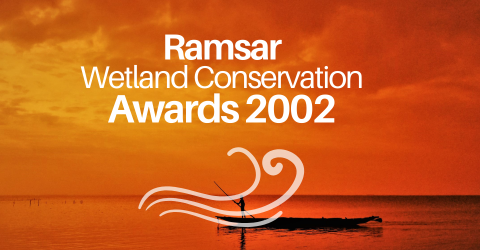
Award 3 2002
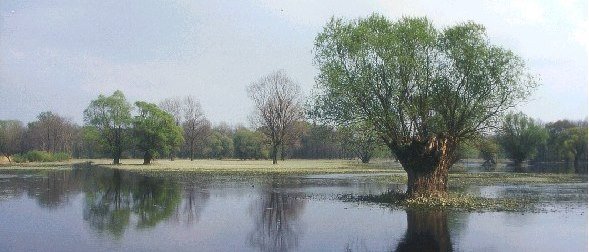
The NGO Trinational Initiative for the Morava-Dyje Floodplain, Daphne (Slovak Republic), Distelverein (Austria), Veronica (Czech Republic), WWF International-Danube Carpathian Programme
These four organizations are being rewarded for the work they have been carrying out for many years at the national level in each of the three countries, and at the international level, to ensure sustainable use and conservation of the natural and cultural heritage of the floodplains of the Morava (March) and Dyje (Thaya) rivers.
The Morava-Dyje riverine landscape is one of the last regions in Europe where traditional land use has secured a rich biodiversity, and today it is becoming a model area for the reconciliation of man and nature. This ecosystem is one of the most valuable wetlands in Europe. A mosaic of meadows, river meanders and oxbow lakes, old hardwood floodplains, forests and reed beds, it is home to an extraordinary variety of wildlife. In their own regions and in collaboration, the four organisations have developed and implemented activities to restore degraded habitats, to use sustainably the resources of the land (notably through the use of traditional and extensive farming practices), and to inform and sensitise the local populations.
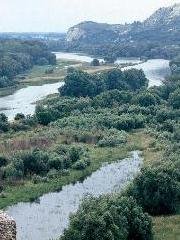
Their activities have lead to the signature, by the Ministries for the Environment of the three countries, of a Memorandum of Understanding to implement the Convention on Wetlands in the transboundary, trilateral area of the "Morava - Dyje Floodplains" and to the establishment of the Trilateral Ramsar Platform in the Morava - Dyje floodplains. In the Memorandum, the three countries agreed to hold annual meetings to coordinate their efforts to achieve trilateral status for the existing Ramsar Sites along the border area of the Morava and Dyje floodplains and to develop their management according to the "Guidelines for management planning for Ramsar Sites and other wetlands". The signatories consider that a trilateral platform, composed of up to 15 experts, representing these ministries, water management institutions, the national Ramsar committees and non-governmental organisations, would form the most convenient way to further trilateral cooperation.
The four NGOs involved in this initiative are fully committed to solving the problems and addressing the threats that are still affecting the region, and to maintaining the ecological character of the sites.
Well-structured and locally well-rooted, this long-term initiative has now gained active support by the respective local and national authorities, as well as by the European Commission. It is backed by good scientific and technical support, which has produced research outputs of importance, recognised at a wider scale. It provides a model of transboundary cooperation and promotion of wise use practices.
The Ramsar Award is being given jointly to the four organizations in recognition of their patient and visionary efforts to ensure a harmonious and sustainable future for this region.
---An interview with Miroslava Cierna from DAPHNE - Institute for applied ecology in Bratislava---
by Gerhard Sigmund, Austrian Federal Ministry of Agriculture, Forestry, Environment and Water Management

Background:
On 30 August 2001, the Ramsar authorities of Austria, the Czech and Slovak Republics met at Zidlochovice Castle in the Czech part of the Dyje floodplain to sign a Memorandum of Understanding on Europe's third trilateral Ramsar Site - in addition to the Waddensea with a common secretariat run jointly by the Netherlands, Germany and Denmark and the Prespa Park declared by Albania, Greece and the FYR of Macedonia. This ceremony was a great moment following a seven years effort made mainly by the non governmental organizations in this region within an unique teamwork : DAPHNE (SK) , Distelverein(A) , Veronica (CZ) and WWF International.
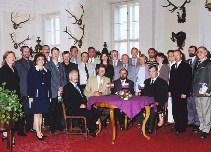
In the Memorandum, the three countries agreed to establish a Trilateral Ramsar Platform, to prepare the declaration of a trilateral Ramsar Site along the border area of the Morava (March) and Dyje (Thaya) floodplains, to develop a trilateral management plan and to enhance their communication and exchange of information activities.
Gerhard Sigmund: The Ramsar sites along the Morava-Dyje area are of unique natural quality. Today we are standing before the designation of a new trilateral Ramsar site in Europe. When we look back, who started with the idea of a trilateral Ramsar cooperation ?
Yes, indeed. The Morava-Dyie floodplains are unique in their richness of habitats and species. They harbour aquatic ecosystems that are typical for European slow-flowing rivers with important fluctuations of water level discharges, including game-abounding alluvial forests and wet meadows. The existing, adjacent Ramsar Sites include the Danube-Morava floodplains on the Austrian side, the floodplain of the lower Dyje on the Czech side, and the Morava floodplains on the Slovak site, covering together more than 55,000 ha land.
The idea of a trilateral co-operation in the Morava Dyje region has been initiated by WWF at first, in the framework of the Green Danube Project. From 1994 on, four organisations WWF, Veronica, Distelverein and Daphne have been working jointly towards the nature protection and sustainable regional development in the border area of Morava and Dyje rivers. Partners have been regularly exchanging information about the development and threats for the area, influencing the environmental policy and enhancing the communication on national and international level among the stakeholders, governmental and non-governmental organisations.
GS: How could you help to enforce the trilateral cooperation ?
Through various restoration activities and scientific research, non-governmental organisations have improved common knowledge of protected areas´ management and increased the quality of information about the region. Among other organisations we have significantly contributed to raising more public awareness and environmental education. This indeed unique NGO initiative also improved the public participation in the regional development, specially in the case of large scale projects having negative impacts on the trilateral area.
But the essential thing was that the 4 NGOs have regularly organised trilateral conferences which were focused on problems of relevance to the present situation of the region such as revitalisation, tourism and regional development and sustainable agriculture.
GS: What is the main success of the 4 NGOs initiative in your view ?
Well I think that the first obvious success of our trilateral initiative was the signing of the trilateral declaration. It was the formal establishment of a co-operation network among the competent management bodies, governmental and non-governmental organisations, stakeholders and local people. With the help of the three ministries it was possible to sign this trilateral declaration on August 30th, 2001 and, by doing so, fix the establishment of a trilateral Ramsar Morava-Dyje platform on the basis of an international treaty. But behind that stands the real success: the development of a strategy identifying the priorities for the region. It has been promoted by the trilateral initiative as a basic instrument for the future development of the area. As we can expect, the strategy will be followed by the preparation of a trilateral management plan and the designation of a trilateral Ramsar site.
GS: Which event was the break-through of your trilateral initiative ?
When I look back, I can see the 4th trilateral conference in Bratislava 1999 as a crucial event. It was entitled „European Model of Protection of the Morava and Dyje floodplains" and was organised by the very NGOs. Yes, this conference confirmed the need to take concrete steps for cross-border management, as well as for the declaration of a trilateral Ramsar site along the Morava and Dyje rivers.
During this trilateral conference a „Common strategy for nature conservation and sustainable use in the trilateral region "Morava - Dyje floodplain" was adopted. Stakeholders working in this region have agreed their intention to improve regional planning, conservation and revitalisation of the natural ecosystem, involving agriculture, forestry, water management and environmental education.
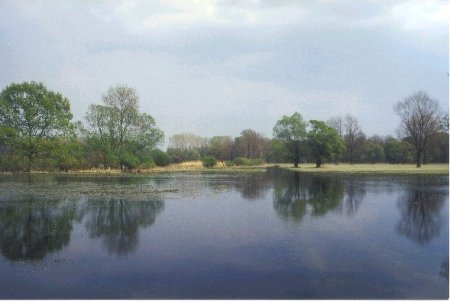
GS: How did the co-operation with governmental organizations turn out ?
Since the beginning of the trilateral teamwork, non-governmental organisations initiated the co-operation with governmental institutions on different levels and provided assistance in the field of nature conservation, public awareness and environmental education. Considering the fact that the non-governmental sector has been created in the Czech and the Slovak Republic only after 1990, the year of fall of the iron curtain, NGOs had to overcome the big information gap and get trust of governmental representatives. But during the past few years, NGOs have developed a good partnership platform and gain high credibility.
Effective communication and close co-operation were especially important during the establishment of the official trilateral co-operation and preparation of the Memorandum of Understanding. The result of the 4th Trilateral conference including the idea of a Trilateral Ramsar Platform has been presented to decision makers, especially to the Ministries of Environment in the three countries, who showed interest to co-operate with non-governmental organisations on that issue. The Ministry of Environment of the Slovak Republic initiated the close cross border co-operation on a governmental level in the Morava - Dyje area among three countries, and, as a response, the Austrian side has organised the first meeting participated by the governmental and non-governmental organisations. Later on, NGOs drafted the Memorandum of Understanding and provided it for comments through the Ministry of Environment of the Slovak Republic. Two years after the first idea, the Memorandum was signed. After all, we can see today that the co-operation between NGOs and GOs worked very well although sometimes we wish that things would go on a little bit faster.
GS: What was your experience in the co-operation with other official organizations?
Management organisations such as protected landscape area offices or water management authorities have also played a very important role in the preparatory process. Despite the fact that the co-operation between NGOs and these management organisations is considered to be good, there are in some areas still significant disagreements on the specific nature protection issues.
Although governmental organisations showed real interest to co-operate with NGOs in many fields, the level of co-operation and the interest depend on country and institution. The main reasons of failed co-operation are difference of opinion on the management of the area, lack of capacity of governmental bodies and missing willingness to find consensus.
GS.: Can you give us examples for important practical achievements of your NGO initiative ?
Oh yes. For example, our participation at the designing and implementation of river restoration measures in the Morava and Dyje floodplain area (river bank and meander renaturation measures in sections of the Morava river) is also including wetland revitalization f. e. the conversion of 240 ha of arable land to species rich meadows in Slovakia and Austria. Furthermore, there has been our intensive lobbing against activities which may have negative impact on the area´s natural value both on national and local level. We have contributed to the improvement of 1000 ha bird habitats in the Czech republic on the Nove Mlyny dam and strengthened the "green" movement to stop navigation of the Morava river and stop all further plans to build the shipping canal "Danube-Odra-Elbe".
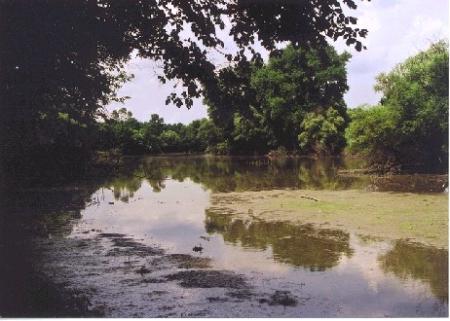
GS: What is your vision for the trilateral Morava-Dyje area?
Our vision ? The Morava Dyje floodplain as a trilateral Ramsar site !
On the basis of the trilateral platform we shall implement efficient nature conservation protection measures in the Morava Dyje region. Concerning level of habitat´s and species´ protection the three states will harmonise their legislation, and they will agree on a common cross-border management plan defining the common aims.
GS: It was a long way from the first idea to a trilateral co-operation until the signing conference in 2001. What are the Lessons learnt ?
First of all the role of NGO may be of crucial importance for the improvement of international co-operation on governmental level. NGOs can significantly contribute to the development of valuable nature areas and attract new financial resources as we could see.
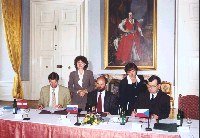
Secondly it is to say that a stable structure and partners as well as a long term financial support are essential for reaching the objectives. At the signing conference of the trilateral Memorandum of understanding in August 30th, 2001 the ministerial delegations underlined the important role played by non-governmental organisations. Daphne (Slovakia), Distelverein (Austria) and Veronica (Czechia), as well as the Danube-Carpathian Programme of WWF International, many thanks to the latter for their financial support of this initiative, promoted the concept and worked together to conserve a "nature without borders" in an exemplary way .
Vienna, 14th October 2002
Miroslava Cierna is working as head of the Environmental Policy Department for the Daphne-Institute of Applied Ecology. She received her Masters in biochemistry and molecular biology from the Faculty of Natural Science of Comenius University in Bratislava (1995). After one year of postgraduate study on environmental management and planning (Academia Istropolitana, 1996) she joined the DAPHNE team and started to work on the implementation of restoration projects and influencing agri-environmental policy. She is experienced in the co-ordination of teams of international NGOs and also in public participation in nature conservation. She has started working in the Morava - Dyje floodplains in 1997 and from 2000 she has been coordinating the common activities of NGO trilateral initiative.